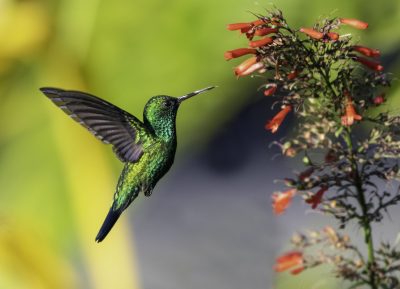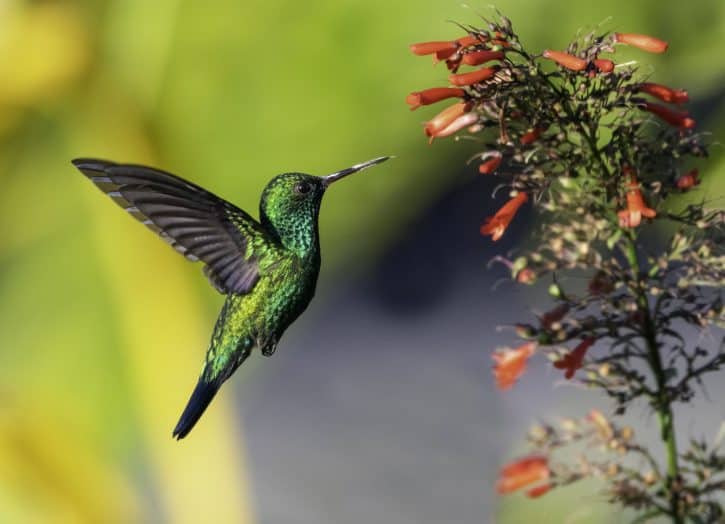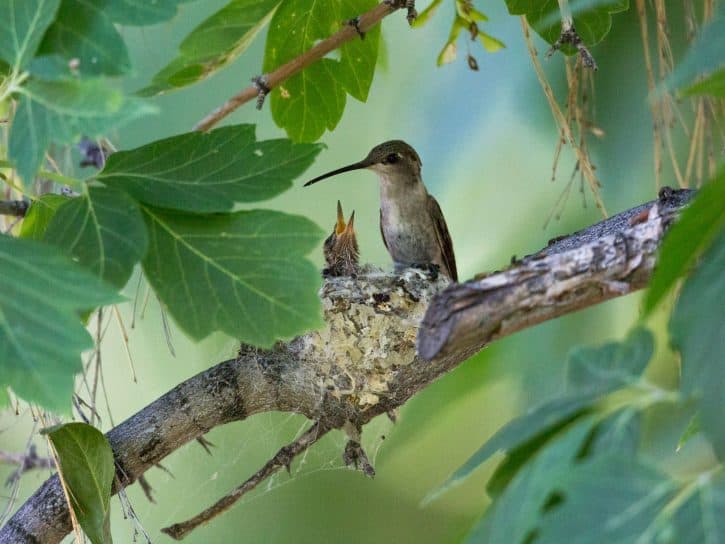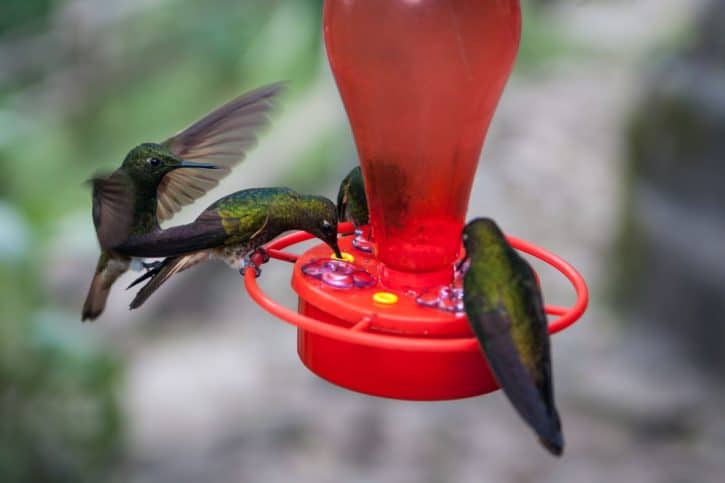What Do Hummingbirds Eat?
May 21, 2020May 30, 2019 by C.B. Daniels


The Short Answer: Hummingbirds eat nectar, sap, juice, insects, and pollen. Although the pollen might not be intentional.
The short answer out of the way, let’s get into a little more detail.
Contents
2 What makes a hummingbird different from other birds?
3 How often do hummingbirds eat?
5 What do baby hummingbirds eat?
6 What do adult hummingbirds eat?
7 Summary of what hummingbirds eat
7.1 Interested in making your back yard a haven for hummingbirds?
8 Here are some more articles you might enjoy
What are hummingbirds?
To be scientifically classified as a bird, an animal must have feathers, wings, a beak, and it must lay eggs.
Hummingbirds take these requirements to the extreme! They have brilliant iridescent feathers that can seemingly change color based on their position to the viewer, relative to the sunlight.
They possess the world’s most aerodynamic wings, beating up to 80 times per second. Their beaks are long and thin, perfect for sipping nectar out of tubular flowers. And they lay one or two of the world’s smallest eggs, each one only about the size of a jellybean.
Hummingbirds are a group of over 300 species of birds in the Trochilidae family, fittingly named because of the humming sound their rapidly beating wings make in flight.
Living for an average of three to five years, hummingbirds thrive in tropical or subtropical climates and are native only to North, South, and Central America, as well as throughout the Caribbean.
What makes a hummingbird different from other birds?
While several species of birds are capable of hovering over an object or their prey, hummingbirds are unique in that they can swiftly maneuver their bodies forwards, backward, side to side, straight up and even upside-down like a tiny, winged acrobat.
In its pursuit of a flower’s nectar, a hummingbird’s head gets covered in pollen which they then transfer to the next flower. As a result, we have hummingbirds (along with bats and insects like bees) to thank for helping pollinate the world’s flowers.
Fun fact: Red is a hummingbird’s favorite color!
Typically ranging in size from three to five inches long, “hummers” are among the smallest birds in the world, with the Cuban-native Bee Hummingbird claiming the title of world’s smallest living bird at just over 2 inches long and weighing less than one ounce. The Giant Hummingbird, native to the western coast of South America, is the largest hummingbird species and measures 9 inches long.

How often do hummingbirds eat?
Hummingbirds eat frequently to support their swift heartrate, high body temperature, and the demands of their incredible wing speed.
To replace the energy expended during a single day, they must eat half of their body weight in sugar every day. They eat the most in the morning (Breakfast is the most important meal of the day, after all!) and end up eating up to eight times per hour throughout the day.
Once it gets dark, hummingbirds typically settle in a safe place and enter a state of deep sleep called torpor, which dramatically slows down their metabolism and conserves energy, just like hibernation. They have even been seen hanging upside down when in this state!
What do hummingbirds eat?
Hummingbirds love sweets and rely on the sucrose found in flower nectar, fruit juice, and tree sap to fuel their bodies. Using their long, forked tongues to reach down into a tubular flower, they sip up the precious nectar at a rate of 13 licks per second.
When a ripe fruit falls from a tree and breaks open, they seize the moment to lap up its juice. Hummingbirds have even been observed as opportunistic little thieves, stealing tree sap that a woodpecker has patiently freed from a tree.
But a hummingbird cannot survive on sucrose alone. Its body also requires protein, fat, and salt, which it obtains from eating a wide variety of bugs: spiders, aphids, flies, parasitic wasps, beetles, mites, treehoppers, flying ants, weevils, mosquitoes, gnats, as well as insect eggs.
What do baby hummingbirds eat?
Baby hummingbirds are born blind and helpless, just as many new animals are. Their mother must leave the nest up to 200 times per day to find food for them since they eat every 20 minutes. She holds nectar in her throat and tiny bugs in her beak and places them directly into her baby’s mouth.
Since a mother hummingbird needs so much food herself, it is a fortunate thing that she only has one or two hatchlings at a time. She gives all the protein-rich bugs to her young and survives on nectar alone during the three weeks it takes for them to become independent and leave the nest.

What do adult hummingbirds eat?
At one point, scientists and bird enthusiasts believed that adult hummingbirds survived on nectar alone. They based this theory on observations of the birds in the wild, which is a challenge because they move so fast and don’t usually stay in the same place for long.
Then they were observed with something a bit more solid in their beaks, which ended up being an insect. The new challenge was to determine if they were going after the nectar and happened to sip up an insect as well, or if the insect was always the primary target, camping out at the bottom of a tubular flower.
Early ornithologists, including museum director and zoologist Frederic A. Lucas, concluded that observation alone was not enough. Lucas dissected a recently deceased hummingbird to examine its stomach contents. (I know, so sad!) He was surprised to find that the bird’s stomach was jam-packed with a great variety of different bugs.
Interestingly, early researchers didn’t find any nectar in the bird’s stomach. German author Walter Scheithauer has since pointed out in his book Hummingbirds that the nectar is so rapidly digested that it wouldn’t be detectable in an autopsy. He determined that the nectar doesn’t even go through the stomach; it goes directly to the intestines due to the unique anatomy of a hummingbird.
Fun fact: Hummingbirds do not use their tiny feet for transportation, but use them for perching and preening only!
Hummingbirds have not been observed directly eating pollen; instead, it is believed to be eaten by accident when it sticks to their favorite types of nectar. Regardless of whether it was sought out, pollen accounts for up to 15% of the hummingbird’s diet.
Summary of what hummingbirds eat
A hummingbird’s amazing body requires that it eat up to eight times per hour to keep up its energy.
The agility of a hummingbird allows it to maximize its feeding options.
Baby hummingbirds are fed by their mothers for the first three weeks of their lives.
Nectar gets digested so quickly that it was absent from a hummingbird autopsy.
To conserve energy and slow down their metabolism, hummingbirds switch into torpor, a deep sleep like hibernation.
Hummingbirds in the wild drink flower nectar, tree sap, and juice from busted-open fruit. They also consume pollen, although it is not clear if that is intentional. Furthermore, they provide natural pest control by eating a wide variety of insects, such as:
Aphids
Bees
Beetles
Flies
Flying Ants
Gnats
Insect eggs
Mites
Mosquitoes
Parasitic Wasps
Spiders
Treehoppers
Weevils

To encourage pollination, gardeners often plant flowers that bees, butterflies, and hummingbirds find attractive. Since their favorite color is red, you find that red birdfeeders filled with sugar-water are the most popular human-made hangouts for “hummers.”
Interested in making your back yard a haven for hummingbirds?
Check out this list of nectar-producing, hummingbird-attracting flowers:
Beard Tongue
Bee Balm
Butterfly Bush
Calico Bush
Columbine
Day Lily
Foxglove
Hibiscus
Hollyhock
Iris
Larkspur
Pentas
Penstemon
Petunia
Phlox
Red Cardinal
Rhododendron
Salvia
Scarlet Sage
Soapwort
Trumpet Honeysuckle
Trumpet Vine
Verbena
Here are some more articles you might enjoy
Hi my name is C.B. Daniels and I make websites. I’ve also always been fascinated by animals. I thought that some of the information about animal diets and pet names was a little thin. So I figured I’d make this site to remedy that! I hope to make this site a hub for information about what animals eat, fun names you can use for your pets, and general animal information. Hopefully, you’ll find all the information about animals you are looking for and much more!
Latest posts by C.B. Daniels (see all)
- Can Rabbits Eat Grapes? - November 12, 2022
- Can Rabbits Eat Cucumbers? - November 3, 2022
- Can Rabbits Eat Spinach? - November 3, 2022